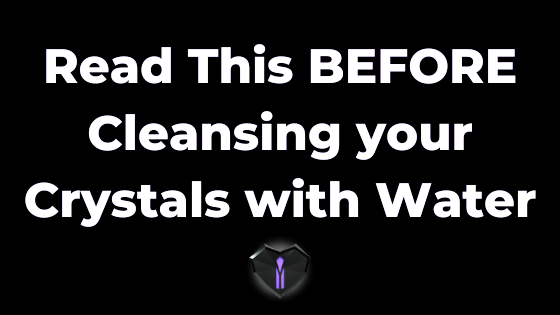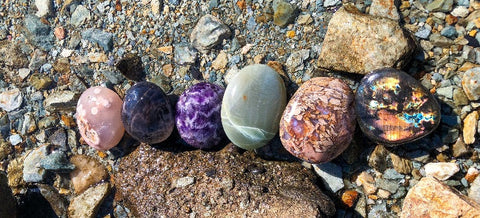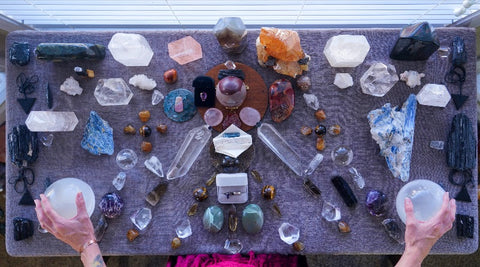
Cleansing your crystals is essential, especially after significant exposure to, and absorption of, negative energy. There are many ways to cleanse your crystals - one popular method includes utilizing bodies of water, such as rivers, oceans, or lakes.
If you follow me on Instagram, (@amarisland) you know very well that cleansing crystals in bodies of water is one of my favorite things to do; not only because it gets me outside and in contact with the Earth, but also because water is extremely purifying. It makes a beautiful sound when rushing. It is powerful, yet it flows gracefully.
It is VERY important to keep in mind, however, that only some crystals can safely be placed in water, especially salt water - it can literally be a matter of mineral life, or death. Some minerals will lose their lustre, others may rust, and many will completely dissolve when submerged in water. Others can last in water for days and come out looking brand new.
So, how do we discern what crystals can be cleansed using water?

Do diligent research and learn cool stuff along the way!
All this talk about destroying your crystals might be frightening, but a little awareness goes a long way. Doing research on the crystal you want to cleanse in water, before you cleanse it, will give you the peace of mind to have a meditative experience. Consider the mineral composition, hardness, and porousness of the pieces in question. Then, utilize the internet - it is abundant with resources that can answer your questions in regards to these 3 things, especially if you are unsure about a specific mineral.
As a general rule of thumb, you should only water cleanse minerals that are a 6, or above, on the Moh's Hardness Scale. This is a 1-10 scale that measures the hardness and scratch resistance of minerals, with 1 being the softest and 10 being the hardest. The softest mineral listed on the scale (1) is Talc. The hardest mineral (10) is Diamond. There are some exceptions, however, so do not rely solely on the Moh's Scale. It is crucial to pay attention to other factors, such as Iron content and porousness (readiness to absorb water).
Iron ores, such as Pyrite, Hematite, Magnetite, and Goethite, should not be cleansed in water for long periods. Why? They will rust when exposed to water for too long and we don't ever want to see our mineral collection go from bright and shiny to dull and rusty. If you do get them wet, remove them from the water quickly and dry them well.
Furthermore, research whether or not the minerals in question will leech toxic chemicals into the water, especially if you plan on leaving them in a bowl of water for an extended period of time. Quick rinses are generally safe, but soaks are an entirely different thing. Potentially toxic minerals include: Malachite (copper), Pyrite (sulphur), Stibnite (lead), Actinolite (asbestos), and others. Gem elixirs are not the topic of this post, but PLEASE, NEVER DRINK GEM ELIXIRS MADE WITH TOXIC CRYSTALS! If you need to, get more clarity on gemstone toxicity.

Be intentional and conscious when it comes to collecting and cleansing minerals!
I read one specific article that mentioned not having time to research crystals when it comes to safely cleansing them in water, so he just avoids it altogether. While this is valid, I also think it is a mistake to negate the importance of learning about your minerals. There is a certain level of regard we all should have for these Earth treasures that add so much value to our lives - crystal collecting may be more common now, but that doesn't mean it should be taken lightly. You don't avoid getting to know someone before becoming their friend, so why would you avoid doing the work to get to know your crystals?
Whether you love your minerals because, "holy cow, I can't believe the Earth made these!", or you use them as tools in your spiritual practice, knowing what they are made of, how they were formed, and how they interact with other elements will enrich your experience and deepen your understanding of them (and their healing properties).
It is never too late to start diving deep into the magical world of geology and the mineral kingdom. Whether you are a beginner collector/healer, or you began your collection a long time ago, consistently take opportunities to learn about your minerals beyond their aesthetic beauty and healing properties. Learn the science behind them, too, because all these things are intimately linked. You will be much more confident in your ability to discern how to properly display, use, or cleanse your crystals.

Water Safe vs. Water Unsafe List
Keep in mind that this list only covers some crystals and is not comprehensive. It will serve as an excellent launching point in your metamorphosis into knowledgeable crystal sage! ;)
Water Safe Crystals:
- Clear Quartz
- Rose Quartz
- Amethyst
- Smokey Quartz
- Citrine
- Agate
- Moonstone
- Carnelian (though NOT safe in salt water)
- Rutilated Quartz
- Jasper
- Tiger's Eye
- Aventurine
- Black Obsidian (FYI: can break in EXTREME cold or hot water temperatures)
The crystals listed above are a great place to start and are especially safe when in polished, or tumbled form. Always double check when it comes to salt water, because salt can be corrosive!
Water Unsafe Crystals
- Fluorite (especially SALT water)
- Selenite
- Apophyllite
- Tangerine Quartz
- Gypsum
- Lepidolite
- Opal (although Australian Boulder Opal is generally safe, because it not porous)
- Azurite
- Apatite
- Halite
- Malachite
- Turquoise
- Ulexite
- Labradorite (I've safely placed Labradorite in water in short bursts and it was fine, but do not count on my experience being the norm)
- Celestite
- Pyrite
- Hematite
Many of the crystals on the unsafe list will completely dissolve when place in water, or they will lose their shine. Either way, play it safe when it comes to these minerals and ALWAYS DYOR (do your own research).
If you ever do make a mistake that damages your minerals, don't be hard on yourself! Remember that experience is the best way to learn. If you are in doubt, do research or select a different cleansing method.
Interested in learning more about crystals, cleansing techniques, meditation, and ways to integrate mind, body, and spirit? Click HERE to follow me on Instagram - @amarisland.
Want new, high quality and hand-curated crystals to add to your collection? Click HERE.
With so much love,
Amaris

Comments
Exelente artículo, mis felicitaciones a él autor o la autora .Me ha fascinado , es realmente muy extraño que me lea un artículo completo, pues suelen ser extensivos y aburridos.
Some polished stones are okay to put in water. There are MANY more stones/crystals that can go into water but that is a nice healthy list so I won’t need or want to put any more down. Although some polished stones are ok to put into water, be careful with unpolished crystals. Unpolished crystals are the ones that you should be careful with. You can still put them into water but I would recommend not leaving them in water for too long. I have learned from personal experiences.
Add Lapis Lazuli to the List for crystals NOT safe in water.